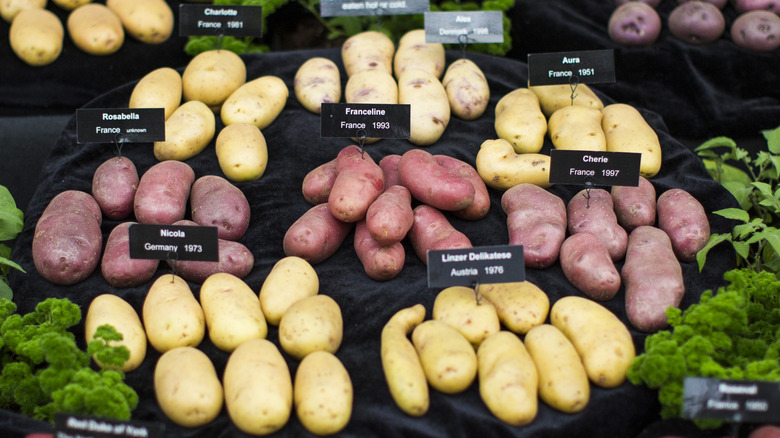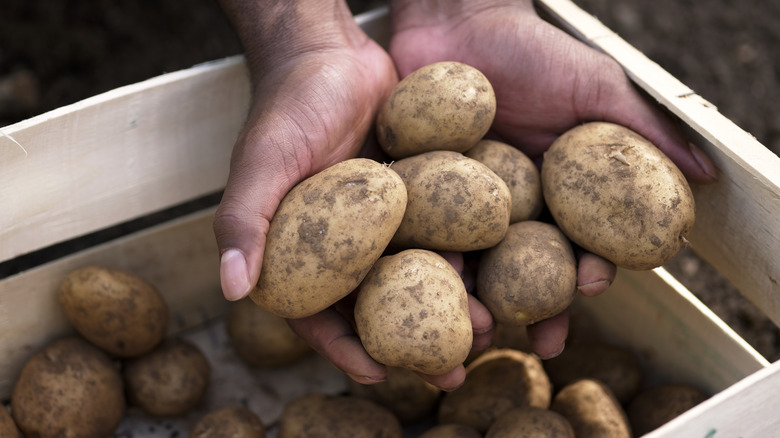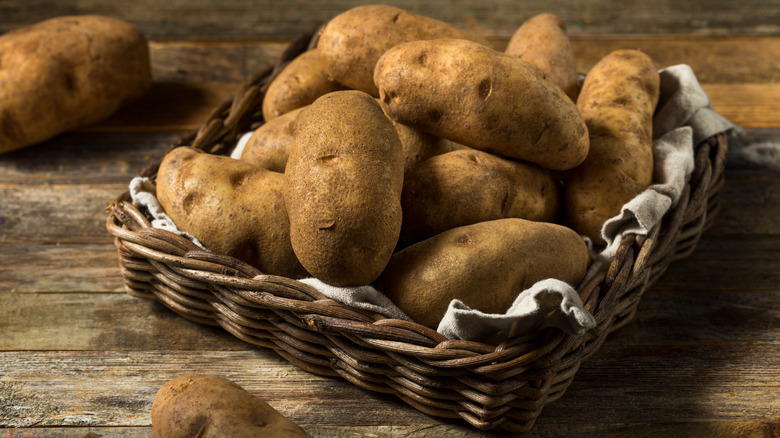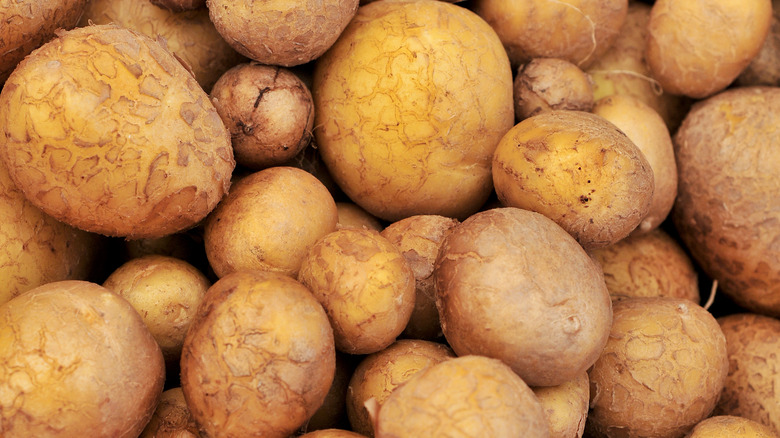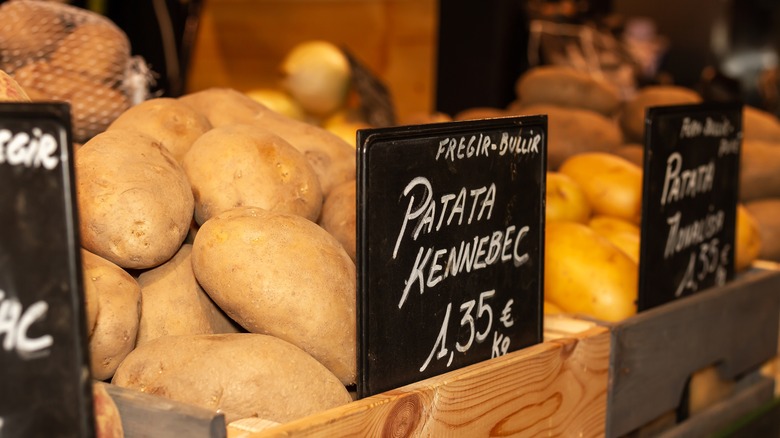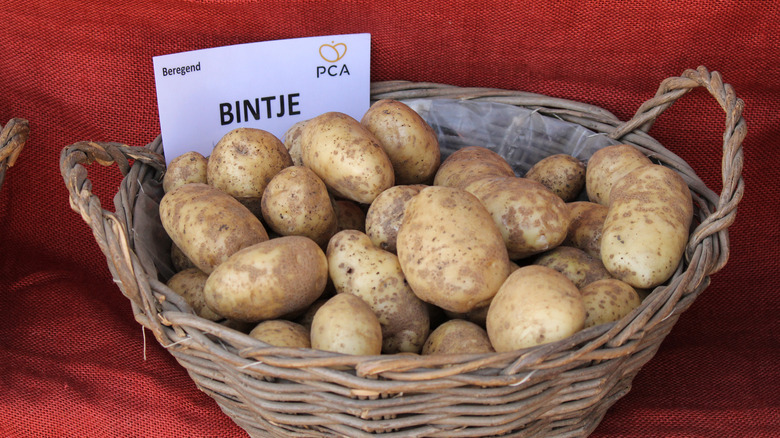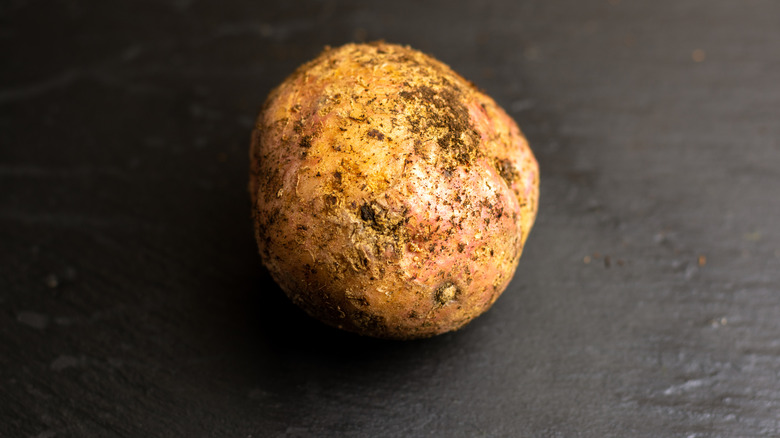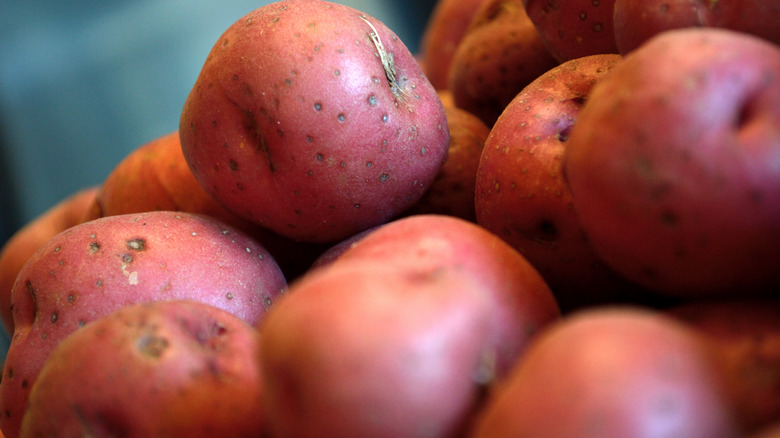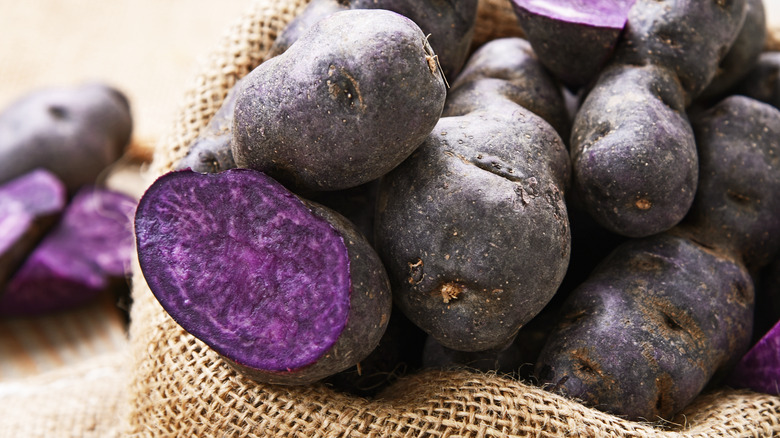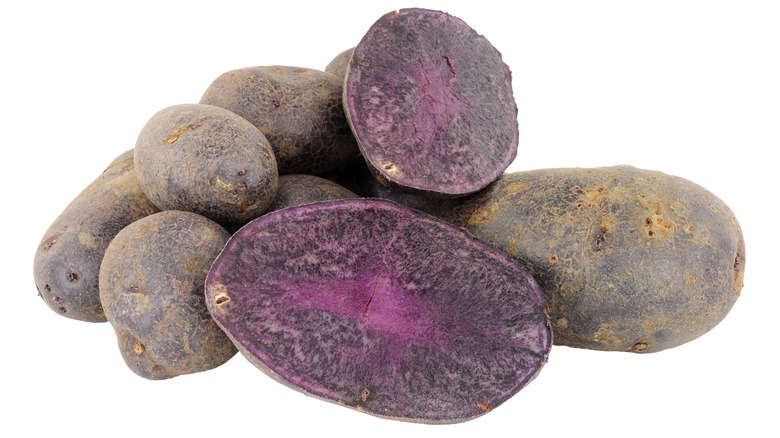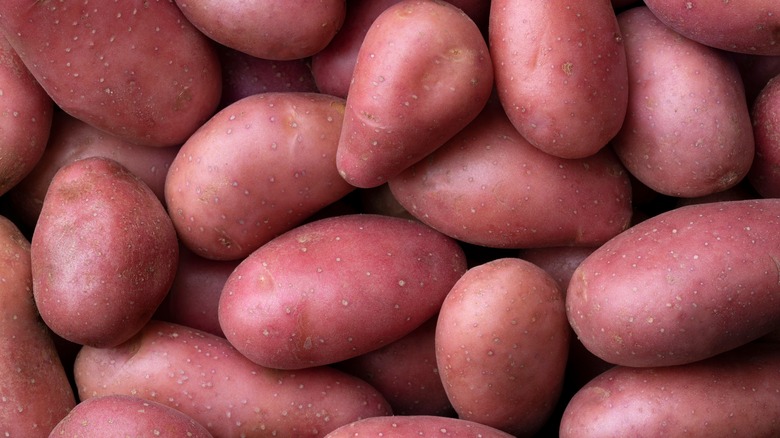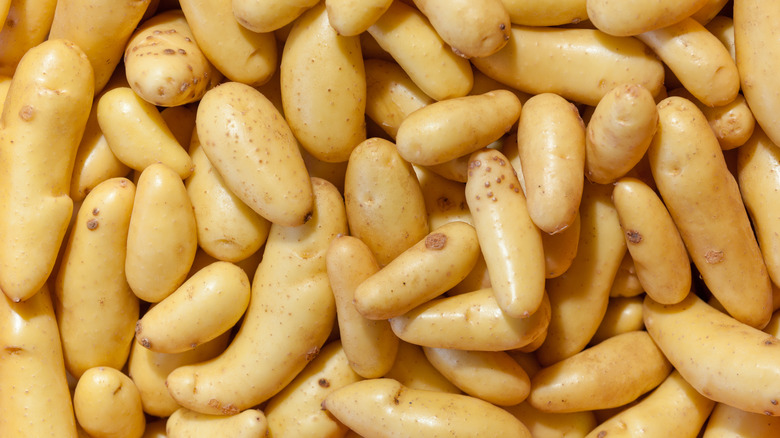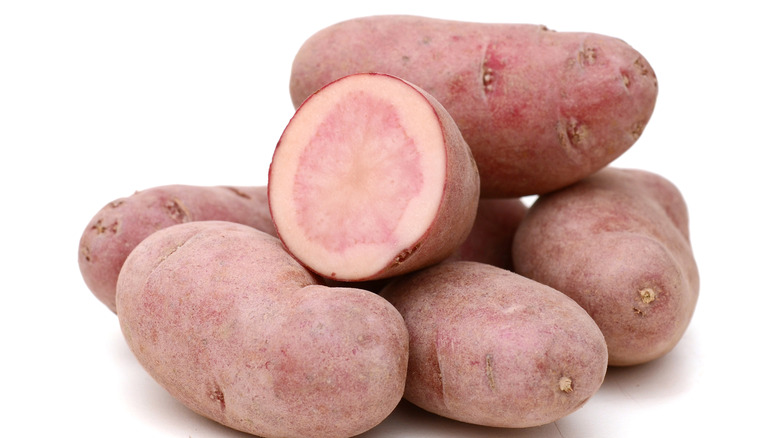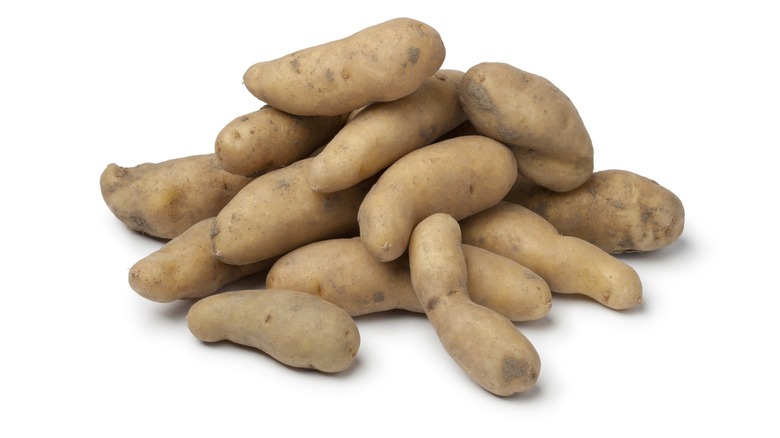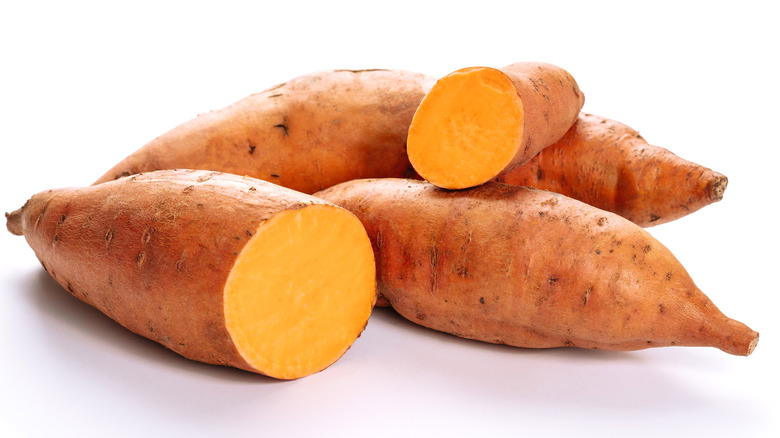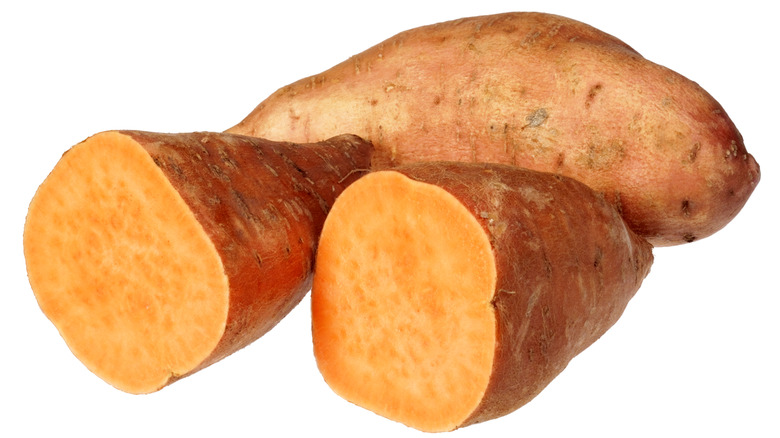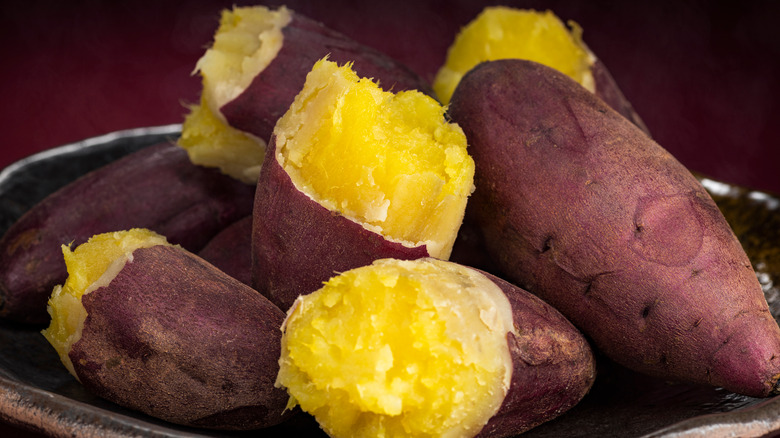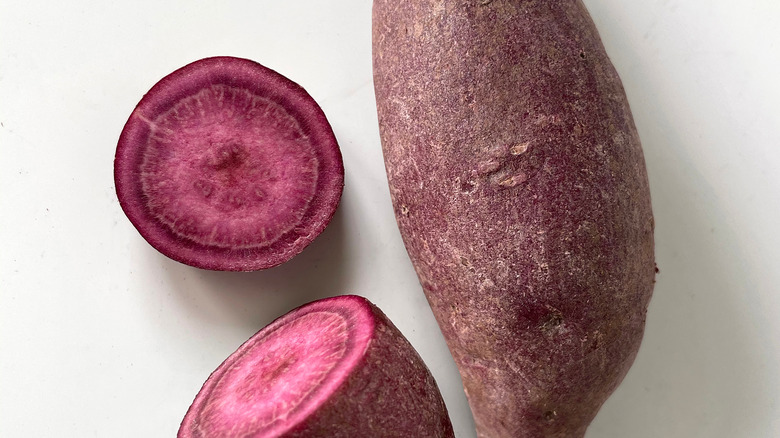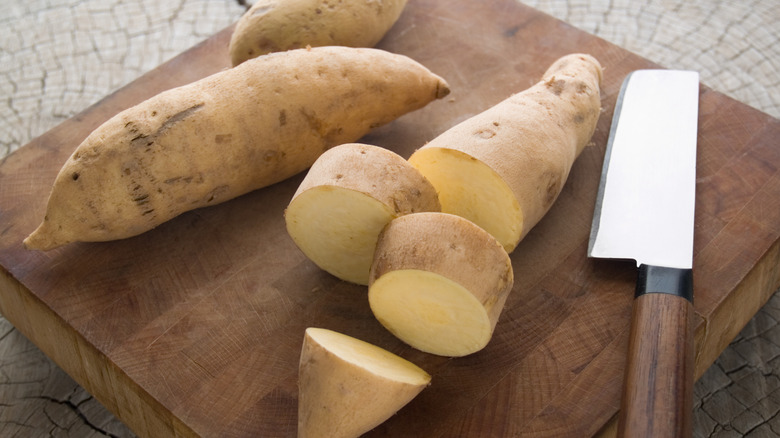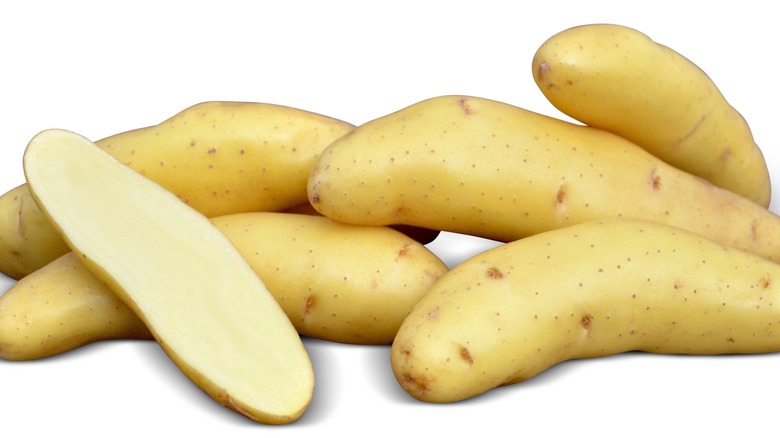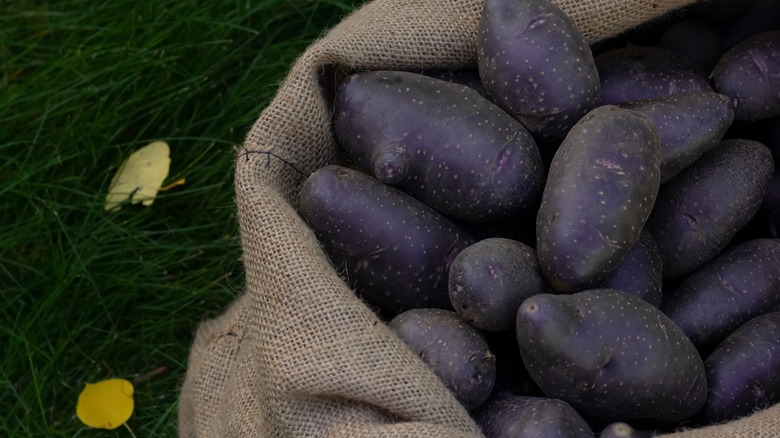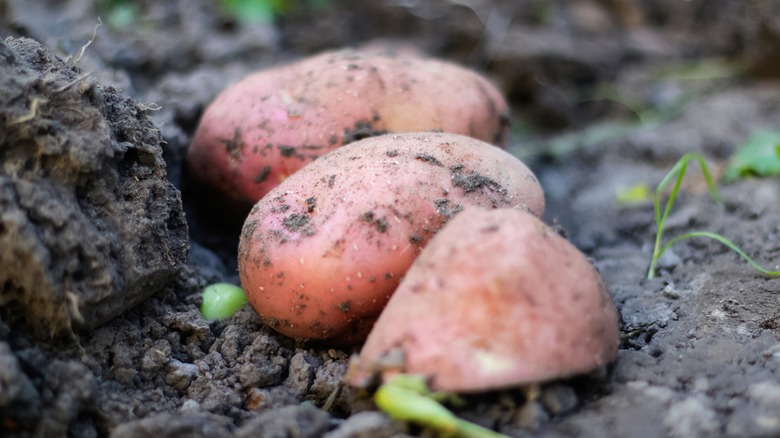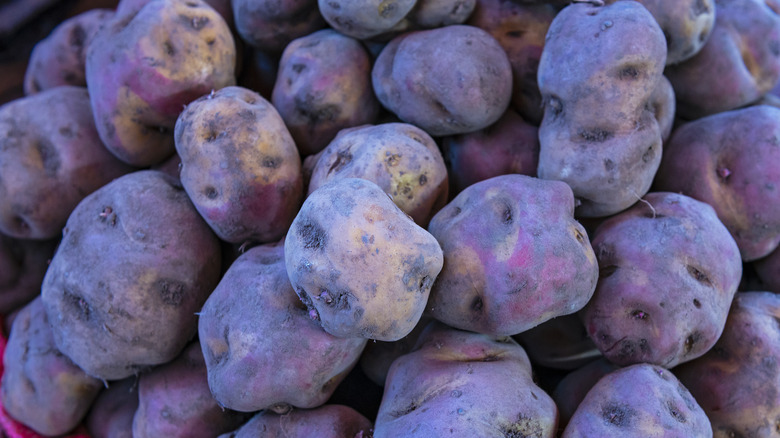23 Types Of Potatoes And When To Use Them
Cheap and readily available, potatoes are among the most favored foods in the United States, with the average American eating approximately 111 pounds of the tuber each year (via Idaho Potato). Their popularity extends well beyond our borders, ranking as the fifth most important crop in the world thanks in part to the Columbian exchange (via Smithsonian Magazine). Indigenous to the Andes Mountains of Peru, potatoes were brought to Europe by the Spaniards. Their importation is credited with solving famine issues in the northern part of the continent. Given the role potatoes played in fighting hunger, it is no wonder why this root vegetable became such an important part of the culture in places like Ireland. They have become so synonymous with the Emerald Isle that many people mistakenly assume they originate from there.
While you may only be familiar with the standard supermarket varieties, according to Potatoes USA, there are over 200 different types of potatoes grown around the globe. With so many options, it can be hard to know which to choose when cooking one of the countless recipes that employ the tuber. This guide will shine a light on some of the most common types of potatoes and ways to use them.
Know your potato categories
When it comes time to select a potato at the local grocery store or farmers market, how do you find the perfect one for your intended use, especially considering how many varieties are out there?
First, you'll need to consider the three primary categories of potatoes: starchy, waxy, and all-purpose. Starchy potatoes are the varieties that have a high starch content (who would have known?) and tend to have a floury texture with soft, white flesh. You'll easily recognize these types of potatoes as your sweet potatoes and russets. The chemical composition of these spuds makes them ideal for baking and frying. We recommend avoiding manipulating starchy potato flesh too much — such as using it to make a potato salad, gratin, or seafood boil — because it doesn't hold together.
If you need a sturdy potato for your potato salad, you'll want to opt for a waxy potato. These varieties have more moisture and sugar, and are smaller than the starchy potatoes. Waxy spuds include Red bliss potatoes and the Russian Banana. The all-purpose is the best of both worlds; they hold together for boiling and have more moisture than a starchy potato. Yukon Golds are a classic of this potato variety, which can be used for almost any culinary purpose.
Russet
The origin of this widely-available potato variety dates back to the 1870s when the Russet Burbank was developed in Idaho (via Idaho Potato). Currently, of the 13 billion pounds of potatoes that are harvested each year from the state, 90% are russets.
The long, oval-shaped tuber tends to be medium to large in size with rough brown skin and a white to pale yellow interior (via Potatoes USA). Russets are highly starchy and are the go-to for baked potatoes and French fries. They are also one of the best types of potatoes for mashed potatoes, given their low-moisture content. They absorb a lot of liquid, resulting in a light, soft texture.
If you are looking for a mouthwatering side dish, try our recipe for easy fondant potatoes. Peel eight russet potatoes and slice the tops and bottoms so they are straight. Heat olive oil in a cast-iron pan and place potatoes flat side down, cooking until brown on both sides. Add butter, rosemary, thyme, garlic, salt, and pepper, cooking for another 2 ½ minutes per side. Coat the potatoes in chicken broth and bake in a 350 F oven for 1 hour. These potatoes will practically melt in your mouth, earning their name which translates from French to mean "melting potatoes."
Yukon Gold
In the 1960s and 1970s, Yukon Golds were developed in Ontario, Canada (via the University of Nebraska-Lincoln). It took some time for these potatoes with golden brown skin and yellow flesh to gain popularity, but now over 1800 acres nationally are devoted to this variety each year. Falling somewhere between a waxy and starchy potato, this all-purpose variety is incredibly versatile, lending to several cooking methods including roasting, frying, boiling, and sautéing.
Using Yukon Golds will give you creamy, dense mashed potatoes as they don't absorb much water, ensuring they are less likely to become gummy. These tubers are also ideal for a German potato salad because they will keep their shape during cooking. Harvested young, baby Yukon Golds are popular for roasting and sautéing. For our Spanish-style potatoes recipe, simply boil peel Yukon Golds in salted water for 20 to 25 minutes, then pan-fry them in olive oil with parsley and garlic until crispy, Finish with butter and parsley. Your potatoes will be crunchy on the outside and tender inside, packed full of flavor throughout.
German Butterball
Introduced in 1988 in Idaho by David Ronniger, German Butterballs are medium to large round potatoes with pale yellow skin and a golden waxy interior (via Nature's Produce). Similar to Yukon Golds, these potatoes are creamy and tender when cooked and give off a buttery flavor. While available all year long, they are in peak season from late spring to early summer (via Gardening Dream).
They do well with steaming, baking, frying, mashing, and essentially any preparation where you might otherwise use Yukon Golds. They also make good roasting potatoes and do not require an excess of seasonings given their naturally rich flavor. Cut your German Butterballs in halves or quarters (depending on their size) and toss with olive oil, salt, and pepper (via The Gardener Cook). Arrange them on a sheet tray and roast at 400 F for about 15 to 20 minutes. Your potatoes should be nicely golden and tender.
Kennebec
This white-fleshed potato was developed by the USDA at the Maine Agricultural Experiment Station in the 1940s (via Specialty Produce). Kennebec is medium in size with light brown skin and white, starchy flesh known for its nutty flavor. These potatoes can be used for baking and mashing, but they are most popular for frying, as they brown evenly. This variety dominates the potato chip market, and the In-N-Out burger chain uses them for their french fries.
Kennebec is a great choice when you want crispy roasted potatoes (via The Healthy Maven). Dice your potatoes into 1-inch pieces and pre-boil them for 10 minutes. Drizzle the drained potatoes with olive oil and a spice mix of mustard powder, garlic powder, chili powder, salt, and pepper. Roast at 425 F in the bottom rack for 20 minutes and then for 20 minutes on the top rack. Let them cool and enjoy!
Bintje
Developed in 1905 by a Dutch schoolteacher, Bintje is now the most popularly planted yellow potato worldwide (via Fedco Seeds). They adapt well to different soil types and store easily. Bintjes are small to medium round potatoes with yellow skin and flesh (via Idaho Potato). These potatoes are good for roasting and frying and are the preferred tuber for Belgian-style pommes frites.
Traditionally, pommes frites (known as pataten and frieten in Belgium) were long strips twice-fried in horse or ox fat (via Taste Atlas). (It is now most common to fry them in vegetable oil.) To make classic pommes frites, peel bintje potatoes and cut them into half-inch-thick slices. Wash off the starch by placing them in water and then pat dry. During the first cook, heat oil to 320 F and fry a handful at a time for 4 to 8 minutes. After the fries cool for about an hour, fry again at 375 F for two minutes. This will get them golden brown and crispy. Pair them with a creamy mayo-based sauce for the ultimate decadence.
Kerr's pink
Often mistakenly attributed to Ireland, Kerr's pink potatoes were developed by J. Henry Kerr in Scotland in the early 1900s (via Grower Experts). This variety, known for its cream-colored flesh and floury texture, gets its name for the rosy patches in its semi-rough skin that is often found full of deep pink eyes. When cooked, they have a light, fluffy consistency. These potatoes do not hold up as well as others, so it is important to not over-boil to avoid turning to mush.
Very popular in Ireland, these are used as an all-purpose potato. While Kerr's pinks are traditionally served boiled with their skins on, they are also used for mashing, roasting, and making chips. To make Irish-style potatoes with Kerr's pinks, boil the potatoes in salted water until you can easily pierce them with a fork (via Our Everyday Life). Melt 2 to 3 tablespoons of Irish butter per pound of potatoes in a large pot and mix in chopped parsley. Finally, toss your drained potatoes in the pot with the melted butter and herbs. You can do this with whole boiled potatoes or, for larger ones, halves or quarters.
Red bliss
These deep red-skinned and white-fleshed potatoes should be familiar to American eaters. In the United States, they are most often harvested young, classifying them as "new potatoes." Red bliss has a low starch content and holds up well to boiling, making them a good choice for potato salad. They can be used for mashing, but beware, they can easily get gummy.
For a perfect side dish, use Red bliss in our Greek lemon potatoes recipe. Slice the potatoes into halves or quarters (about 1 inch wide) and spread them into a 13x9 baking dish. Whisk together lemon juice, olive oil, chicken broth, salt, and oregano, and pour over the potatoes. Cover with foil and bake for 50 minutes and then another 25 to 35 minutes uncovered. The liquid should evaporate, ensuring the bottoms of the potatoes are nice and crispy with each bite packed full of lemony flavor.
Vitelotte
These stunning potatoes have a long history, dating back nearly 800 years (via Specialty Produce). Despite the French-sounding name, they were first grown in Peru, not Europe — they were given the name Vitelotte Noir when they were introduced to France in the 1800s. Today they are primarily produced in France and the United Kingdom year-round, although they can be found in specialty produce markets in the United States.
Vitelottes are small to medium potatoes with a long slender shape and a bumpy texture. The skin ranges from dark purple to violet with deep purple flesh speckled with white patches. Thankfully, they do not lose their color during cooking (via Slow Food Foundation). Known to have notes of chestnut flavor, they are often used in soups and purees, or fries and chips, all of which show off the potato's unique hue. Combined with pancetta, blue cheese, and cherry tomatoes, Vitelotte will produce a vibrant potato salad (via Apron and Sneakers).
Purple Majesty
This striking potato was developed by a Colorado State University research team in an attempt to create a healthier potato (via Innovatio News). The Purple Majesty is particularly known for its high levels of antioxidants, which are four times that of a standard potato. With dark purple skin and deep purple flesh, this is another tuber to select if you want to add a pop of color to your dish.
Purple Majesty potatoes have a fairly low starch content, making them similar to Yukon Gold. Cook's Illustrated does not recommend using them in situations where you need the starchiness that varieties like russet provide. The publication experimented with using Purple Majesty in gnocchi, and the results were dense and gummy. These tubers are better suited for roasting or frying since these methods will keep the integrity of the potato is kept intact. According to CC Grow, Purple Majesty have a short shelf life, so make sure to consume them immediately after purchasing.
French fingerling
The French fingerling (originally called Roseval) was developed by the National Federation of Producers of Potato Plants in France and released in 1950 (via the University of Florida). These are small to medium potatoes with a long cylindrical shape. However, they are larger and more rounded at the ends than other types of fingerlings (via Johnny's Seeds). They have a rose-pink skin with white flesh that sometimes has pink marbling.
These fingerlings are ideal for boiling, roasting, and adding to soups (via High Mowing Seeds). They have a buttery quality with a sweet and nutty flavor (via Renee's Garden). Several seed companies, including Renee's Garden, recommend this variety for potato salad, as they hold their shape well and boil quickly. They can also be used in any recipe that generally calls for fingerlings, so feel free to add a drizzle of olive oil and a sprinkle of salt before a trip into the oven.
Russian Banana
These smaller-sized fingerlings are so named due to their 18th-century Baltic origins and oblong and often crescent shape — in other words, don't expect notes of banana (via Nature's Produce). Russian bananas sport a smooth khaki-colored skin with yellow flesh that when cooked, becomes fluffy with a distinct nuttiness. It's no wonder these potatoes are popular throughout Europe and North America.
Russian Bananas hold their shape well during boiling, making them another popular choice for potato salad (via Renee's Garden). They are also well-suited for grilling, roasting, and steaming. Renee's Garden recommends parboiling them in water and then finishing them on the grill on skewers. This variety would work well in our recipe for the best parsley potatoes. Slice the fingerlings in half and boil until they are tender enough to pierce with a fork. While the potatoes are cooking, infuse some melted butter with crushed garlic cloves. Pour the garlic butter over the cooked potatoes and toss with parsley and salt.
Red Thumb
A variety of fingerling, Red Thumb has ruby skin and marbled pink and white flesh with a distinct tubular shape. These potatoes are considered sweeter than Russian Bananas and have a lower starch content (via Idaho Potato).
Like other fingerlings, their creamy texture and buttery flavor make them versatile and well suited for several cooking methods, including roasting and braising (via Smart Gardener). Red Thumbs could be used in most recipes that call for fingerling potatoes. The Maine Potato Lady calls for roasting them with olive oil and rosemary until they caramelize and serving them as a side for steak. For a colorful plate, try roasting them alongside a few other fingerling varieties. Red Thumbs would also offer a unique look for a potato salad, and since they hold their shape well with cooking, they would be a prime candidate beyond simply providing added visual appeal.
La Ratte
La Ratte is another common type of fingerling potatoes. They look similar to Russian Bananas with their oblong curvy nature, but they have a more irregular, bumpy shape (via Kitchen Garden Seeds). The interior is yellow, and its unique tender flesh gives off notes of hazelnut when cooked. Originally cultivated in France in the 1800s, this fingerling variety almost became nonexistent by 1934, but it made a comeback when it was reintroduced to the potato market in 1965 (via Paris Potato).
La Ratte are one of the more highly-prized varieties on the market because they are hand-harvested and not widely cultivated (via Specialty Produce). Domestic La Rattes are grown in the Pacific Northwest, which has a similar climate to Burgundy, France (via Baldor Food). Since these heirloom potatoes are more delicate, they will not store as long as other fingerlings. Decorated French chef Joël Robuchon used this variety in his signature purée de pommes, a silky smooth potato puree packed full of butter for a luxurious, decadent dish.
Beaureguard sweet potato
The Beauregard sweet potato was first cultivated in 1987 at the Louisiana Agricultural Experiment Station, and it quickly became a popular variety throughout the United States (via Louisiana Agriculture in the Classroom). Beauregards are typically large with a reddish-purple skin and bright orange flesh that gets very tender and creamy when cooked (via Kitchen Garden Seeds).
These sweet potatoes are excellent when baked, fried, or mashed. You can make an impressive side dish with our recipe for easy Hasselback sweet potatoes. Place your sweet potatoes between two chopsticks, so you do not cut all the way through to the bottom. Make slices in the potato about a half-inch apart and arrange the potatoes on a sheet tray. Brush the potatoes with a mixture of melted butter, salt, pepper, garlic powder, red pepper flakes, and maple syrup, then bake for 45 minutes at 400 F and sprinkle with sage at the end. This will give you an earthy yet sweet and satisfying dish.
Jewel yams
Despite their name, jewel yams are sweet potatoes, not yams (via Taste Atlas). Large and oval-shaped with tapered ends, they have copper skin with orange flesh that maintains its brightness after cooking.
Developed in the United States in the mid-1900s, jewel yams continue to be a favorite for baking, roasting, and mashing. They are also ideal for dessert preparations such as our sweet potato pie recipe. To make the crust, pulse pecans in the food processor and add flour, ginger, salt, and cinnamon. Cut cold butter into the flour mixture until it is mealy with pea-size pieces of butter, and add ice water until a dough is formed. While your dough is chilling in the fridge, roast sweet potatoes at 350 F for one hour. Remove the skins and puree the potatoes in the food processor along with melted butter, eggs (whole eggs and extra yolks), sugar, spices, vanilla, milk, and bourbon. Roll out your dough and par-bake it for 8 minutes using pie weights such as dried beans. After removing the weights, pour in your sweet potato filling and bake until the custard is just set (around 45 minutes).
Japanese sweet potatoes
Known by multiple names in Japan including satsumaimo, these sweet potatoes were introduced to Okinawa in 1605 via China and spread to cultivate across the islands (via Stripes Okinawa). After World War II, this tuber variety was used to fight the post-war famine. Japanese sweet potatoes have a red-purple skin with yellow flesh, making them distinct from American sweet potatoes (via The Woks of Life). Other differences include the texture and flavor. These sweet potatoes are slightly fluffier and starchier than orange sweet potatoes, and they have a candy-like sweetness to them.
Japanese sweet potatoes are very easy to prepare. The Woks of Life calls for roasting them by first poking holes in the potatoes to vent them. Then, simply bake them at 425 F for 45 to 50 minutes (until they are fork-tender). As an alternative method, the Japan Living Guide recommends cooking them in a vegetable steamer for 15 minutes, explaining that baking them in the oven can lead to drying out the potatoes.
Stokes Purple
The Stokes Purple is an American-born sweet potato with brown-purple skin and vibrant purple flesh. Though the variety originates from Stokes County, North Carolina, they are mostly grown today in Central California (via Frieda's). According to the Los Angeles Times, Mike Sizemore, the farmer who developed these potatoes, obtained a patent for them in 2006.
Stokes Purple, which offers a toned-down sweetness when compared to its orange-hued cousins, is best when roasted, steamed, or baked. Running to the Kitchen calls for roasting and smashing these purple sweet potatoes. First, cut the potatoes into 1-inch thick slices and boil them for 15 to 20 minutes, until they are tender. Arrange the slices on a baking sheet and gently crush each potato with the back of a fork. Spoon on a mixture of melted ghee, rosemary, and garlic and bake at a high broil for 10 to 12 minutes. The tops and sides should be crispy but the centers will remain tender.
Hannah sweet potato
Hannah sweet potatoes aren't the top dog of the sweet potato world; that honor would go to the ubiquitous orange variety. But Hannah is a force to be reckoned with. These spuds have the dense texture of a white potato but the outward appearance of a sweet potato. As a result, they tend to be too dense to be substituted for any orange sweet potato recipe.
You can identify a Hannah sweet potato by its pale brown skin, oblong shape, and smooth texture. Raw Hannah sweet potatoes tend to have a hard texture and pale color, which turns yellow after cooking. The potatoes also have a low moisture content compared to the orange sweet potato, so they won't produce a similar texture when added to a pie or mashed with butter.
Hannah sweet potatoes are best used for baking into homemade fries or wedges, or tossed into a stir-fry with other favorite veggies. You can also deep-fry these spuds or mash them into a delectable gnocchi.
Austrian crescent
Austrian crescents are a version of small fingerling potatoes. This variety is quite waxy on the outside with firm, yellow flesh on the inside. These potatoes are often called kipfel or kipfler — named after a gracefully curving European pastry — but some specialty produce places will call them by their Austrian moniker.
Since these potatoes are relatively small and dense, they can be used for a potato salad without fear of breaking apart. We love the crunch of biting through one of these potatoes, especially when it's seasoned with savory accompaniments like garlic, sea salt, and cracked black pepper. Another application where these potatoes shine is for roasting. You can boil them in salted water to soften them before tossing them in oil and popping them on a baking sheet. In a short while, you'll be rewarded with crispy-skinned spuds that have a satisfying crunch and can be a blank canvas for flavors and herbs.
Red gold
Red gold potatoes are an early-maturing variety that offer a unique surprise when you cut into them. The red-skinned potatoes can be sliced to reveal bright golden-colored flesh, which might be one reason for the name. It's also believed that this potato variety was named after the Red River, which serves as a border between North Dakota and Minnesota.
One key identifier for this potato is its relatively thin skin, which holds up well to roasting, steaming, and even frying. You can also use these all-purpose potatoes for mashing and baking; the color contrast between the skin and the flesh provides a beautiful (and tasty) experience for potato aficionados. Folks also love the subtle nutty flavor of this tuber, which pairs well with a slab of melted butter, herbs like tarragon and rosemary, or a bit of flaked sea salt on top. The one downside to this variety is that it can only stand three to four months of storage, so you'll have to eat it up before then.
All blue
All blue potatoes are considered a heirloom variety, meaning that these tubers were passed down from generation to generation in small-scale agriculture. In the case of this variety, these spuds are said to date back more than a century. You may also hear these potatoes by other names including Blue Marker, Fenton Blue, and River John Blue. These potatoes have bright blue skin and flesh, a distinctive white ring on the inside, and an oblong shape with deep eyes.
This spud variety is considered an all-purpose, meaning that you can use it for sautéing, steaming, or mashing. It has an outstanding flavor and creamy texture when cooked, and can be combined with other potato varieties to make a red, white, and blue potato salad for your next patriotic get-together. These medium-sized potatoes are also relatively easy to work with and available towards the end of the potato-growing season.
Desiree
Desiree potatoes are an incredibly versatile variety. Boiling, mashing, frying, and roasting are all solid uses for this type of potato, but the consistency doesn't tend to favor steaming. The red, glossy skin is a beautiful shade, and the potatoes can be grown to be quite large, or harvested standard-sized if picked earlier in the season. The flesh of these spuds is pale yellow and firm, which puts it into the classification of an all-purpose potato.
Desiree potatoes were originally grown in Holland in the 1960s, but made their way to Italy within the next decade. This variety is praised for its high disease tolerance and its earthy flavor across Europe. The crop is especially cherished in the Italian village of Colfiorito, where it is celebrated annually with a red potato festival featuring an array of locally made signature dishes using the Desiree potato, including gnocchi and tuber-infused sausages.
Purple Peruvian
Purple Peruvian potatoes are prized for their bright color. As suggested by their name, this potato crop is traceable back to South America. However, it has expanded its range past Peru and Bolivia to be grown in North America and Europe. You'll most likely find it at a farmers market rather than at a grocery store.
This variety has a beautiful, dark purple skin encasing dry purple flesh. When the potatoes are cooked, the color lightens and the flesh has a texture akin to a starchy russet. But if you give us a choice of the russet or the bright purple hue of these potatoes, the answer is already clear.
The starchiness of the Purple Peruvian lends itself well to several different culinary applications. The potato itself is usually fingerling size, and many people will cut them thinly and fry the slices, or roast them in halves. However, the potato can also be scalloped or used for braising or boiling.
